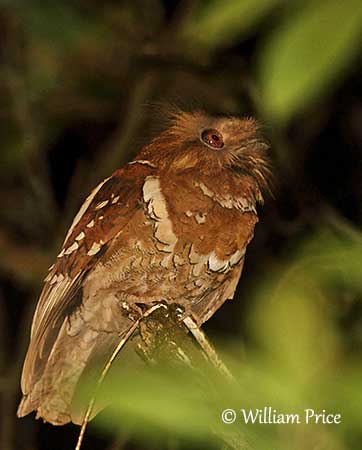
The breeding behaviour is poorly known. This species nests in trees and both adults share the nesting duties.
The Philippine Frogmouth is probably sedentary.
In flight, male and female lack white markings on wings and tail.
REPRODUCTION OF THIS SPECIES:
The breeding season takes place between April and June/July.
The Philippine Frogmouth builds a small, cup-shaped nest on a horizontal branch in tree, between 2 and 5 metres above the ground. This small structure is made from adult’s downy feathers held together with spider webs, moss and lichens.
The female lays a single egg per season, rarely two. Both adults share the incubation, the male during the day and the female at night. The incubating bird is usually sitting crosswise on the nest. No more information.
PROTECTION / THREATS / STATUS:
The Philippine Frogmouth is usually described as uncommon. The species is threatened by heavy deforestation throughout most of the Philippines.
The population is suspected to be declining, but currently, the Philippine Frogmouth is not globally threatened and evaluated as Least Concern.
Fr: Podarge des Philippines
Ang: Philippine Frogmouth
All: Philippinenfroschmaul
Esp: Podargo Filipino
Ita: Bocca di rana delle Filippine
Nd: Filipijnse Kikkerbek
Sd: filippinsk grodmun
Photographer:
William Price
PBase-tereksandpiper & Flickr William Price
Text by Nicole Bouglouan
Sources:
HANDBOOK OF THE BIRDS OF THE WORLD Vol 5 by Josep del Hoyo-Andrew Elliott-Jordi Sargatal - Lynx Edicions - ISBN: 8487334253
A Guide to the Birds of the Philippines De Robert Kennedy, Pedro C. Gonzales, Edward Dickinson, Hector C. Miranda, Jr, Timothy H. Fisher – Editeur: OUP Oxford, 2000 – ISBN: 0198546688, 9780198546689 - 169 pages
NIGHTJARS - A Guide to Nightjars and Related Nightbirds – Nigel Cleere and Dave Nurney - Yale University Press - First Edition (August 11, 1998) - ISBN 10: 0300074573 / ISBN 13: 9780300074574
Nightjars and Their Allies: The Caprimulgiformes De D.T. Holyoak – Editeur : OUP Oxford, 2001 – ISBN: 0198549873, 9780198549871 – 773 pages
Birding Adventure Philippines - Philippine Frogmouth
Animal Database - Philippine Frogmouth
PLANETOFBIRDS.COM
Wikipedia, the free encyclopaedia
Philippine Frogmouth
Batrachostomus septimus
Podargiformes Order – Podargidae Family
INTRODUCTION:
The Philippine Frogmouth is endemic to Philippine Archipelago where it occurs in forests and at forest edge from lowlands to mountains, up to 2,500 metres of elevation.
It feeds on large insects caught with the large, frog-like beak. This species builds a nest on a horizontal branch, and a singly egg is laid, incubated by both parents. It has nocturnal habits.
The Philippine Frogmouth is affected by habitat destruction and its population is decreasing, but currently, it is not globally threatened.
DESCRIPTION OF THE BIRD:
Biometrics:
Length: 25 cm
Weight: 75-96 gr (nominate race)
The Philippine Frogmouth of nominate race “septimus” has two morphs and intermediates. We can find brownish and rufescent morphs.
It has rufous-brown upperparts with chestnut wash. There is a distinct buffish to whitish-buff collar on the hindneck. On the upperwing, the wing-coverts are like the upperparts, but they show conspicuous pale buff spotting. The scapulars are mainly pale buff with brown speckles and vermiculations.
The underparts are rufous-brown, but also tawny or buffy, with pale buff and brown speckles, spots and bars. We can see two broad pale buff bands, one around the lower throat and a second band around the lower breast.
On the head similar to the upperparts, the crown is barred tawny or buff. There is a pale, cinnamon-buff supercilium. Long bristles are extending from the face to the base of the bill. These long, thin feathers are thought to protect the eyes, but they also detect the movements of the prey within the forest habitat and in the darkness.
The small, hooked bill with a wide mouth (frog-like mouth) is pale blue-grey. The eyes may appear pale yellow to brown or speckled with gold, depending on the light. Legs and feet are pale flesh.

Male and female are similar, although the female is mostly darker with plainer appearance.
The females of both morphs show narrower white collar on hindneck, less white on the wing-coverts and no pale markings on scapulars.
The juvenile is not described.
SUBSPECIES AND RANGE:
The Philippine Frogmouth has three subspecies that differ mainly in size.
B.s. microrhynchus is found in N Philippines (Luzon and Catanduanes).
B.s. menagei occurs in W Philippines (Panay and Negros). This race is very rare.
B.s. septimus (described above and displayed) is found in EC Philippines (Samar, Leyte, Bohol, Mindanao and Basilan).
HABITAT:
The Philippine Frogmouth usually prefers forest habitats including forest and forest edge from lowlands to 2,500 metres of elevation at least.
CALLS AND SONGS: SOUNDS BY XENO-CANTO
The Philippine Frogmouth male gives a series of short, crow-like “woah”, or “waah” or “guaw”. We can also hear a short, faint trill.
The female produces a short, loud, mewing call descending in pitch.
BEHAVIOUR IN THE WILD:
The Philippine Frogmouth typically feeds on large insects such as cicadas, grasshoppers, crickets and beetles.
The bird is nocturnal. It hunts from perch from which it flies out to catch the prey on the wing with its large bill.
It spends the day perched in vertical posture in tree. Its cryptic plumage makes it similar to a branch and invisible.
